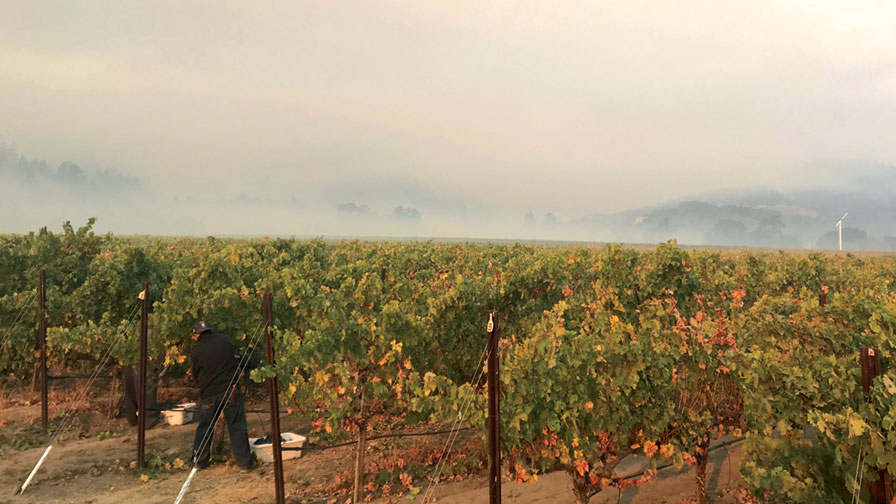California Wildfires Lead to Concern over Smoke Exposure in Grapes

Smoke from wildfires near the Oakville Experimental Station is seen in the vineyard on Oct. 17. (Photos: Anita Oberholster)
The wildfires that occurred in Northern California in early October left several wineries destroyed and many others damaged. Following the fires, there are now questions surrounding those grapevines that survived, and whether they will be affected by the smoke exposure.
According to a report from Anita Oberholster, University of California (UC) Cooperative Extension Specialist in Enology, and Karen Block, UC, Davis, Viticulture and Enology Director of Industrial Relations, when the wildfires began, it was estimated that about 90% of grapes in the area had already been picked, meaning that only a small percentage of this year’s harvest will be impacted by the wildfires and smoke.
According to the report, grapevines are resilient and do not burn easily, and in many cases the vineyards acted as a fire break, helping to limit the amount of damage from fires.
“We expect that the grapevines will recover fully if they did not actually burn, although yield may be impacted,” Oberholster and Block write.
Test for Risk
Wineries are advised to test their grapes to determine the potential risk of smoke taint in wines. Smoke is not expected to be a problem on grapes already crushed, as fermenting wines will be protected by the released carbon dioxide and finished wines should be sealed to protect against any smoke that may have entered the winery.
Even though grapes can be tested, the predictive ability is not guaranteed.
“It is more an indicator to use care when processing the grapes and not introduce any element that can add additional smoky character,” they say in the report. “It is important to note that the compounds that are responsible for smoke taint are naturally present in the grapes at low levels, and that they are also part of the pleasant aroma compounds that are released into the wine during barrel aging.”
Studies to determine the amount of smoke exposure required to result in smoke taint are still underway; however, the risk of smoke taint increases with continual or repeated exposure of heavy smoke, meaning any exposure to heavy smoke can potentially cause problems.
Oberholster says more will not be known on the subject until after the wines have been made and new growth has occurred. In the meantime, she says there is not much that can be done, except to reinstall trellis wires, end posts, and irrigation systems where needed.
Smoke Taint Research in Australia
Smoke taint resulting from wildfires has been studied in Australia for more than a decade. According to Mark Krstic, Business Development Manager for the Australian Wine Research Institute, smoke taint was first observed in 2003, but prior to that, there was no association made between smoke from wildfires and taint in wine. Since 2003, there have been other significant bushfire events in Australia, which Krstic says resulted in major smoke taint problems in 2007 and 2009.
“As the risk of wildfires increases as a result of a changing climate, this has become an important factor to consider (in) future grape and wine production,” he says.
Krstic says when grapes are exposed to smoke, compounds in the smoke called volatile phenols are absorbed by the grapes that are near harvest. These volatile phenols, such as guaiacol and 4-methyl guaiacol are primarily responsible for the sensory perception of smoke taint in wine.
Grapes are susceptible to the uptake of smoke-taint compounds from just before veraison through harvest. Smoke exposure can lead to increased concentrations of volatile phenols and their glycosides, but not necessarily always.
When asked about the possible methods to mitigate the effects of smoke taint, Krstic says “Essentially, there are a number of options that producers have to reduce or minimize impacts, but nothing yet that completely solves the problem.”
Current options depend on wine style and degree of contamination with smoke-related phenols. They include:
- Minimizing extraction of smoke-taint compounds out of grapes,
- Treatment of affected wines by reverse osmosis. Krstic noted that this may be somewhat effective at reducing the free volatile phenol levels, but has little or no effect on their glycosides,
- Treatment using commercial fining agents, such as activated carbon,
- And use of oak chips and tannin additions.
New Research on Smoke Taint is Underway
Tom Collins, an assistant professor at Washington State University’s Wine Science Center, recently put out a request to growers whose vineyards may have been affected by smoke exposure. He is seeking samples of wine suspected of smoke taint for chemical and sensory evaluation, with the objective to identify marker compounds that are better correlated with the perception of taint.
According to the request from Collins, a major issue for growers and wineries evaluating their risk for smoke taint is determining the concentration of guaiacol, 4-methyl guaiacol, or their glycosides, needed to create significant risk. While those compounds are sufficient markers for fruit exposure to smoke, they are not well correlated with the intensity of smoke aromas and flavors in the resulting wines.
Collins is reaching out to wineries in California who suspect they may have wines that have been impacted by the smoke from the recent wildfires.
“The resultant data is critically needed now as we struggle to fill important gaps in current knowledge about the impact of smoke exposure on grapes, juices, and wine, both short and long term. Knowing more about the compounds involved in what we are calling ‘smoke taint,’ will allow researchers to develop effective remediation techniques,” the message from Collins stated.
Complexity of Exposure
Collins hopes the research will shed some light on a complex matter and help to gain a better understanding of how different factors affect smoke taint, such as the amount of smoke a vine is exposed to, how close the fire is, and what sorts of materials are burning.
For example, Collins says they see smoke from both forest fires and bushfires affecting vineyards, but it’s not known whether the different fuel sources play a role in the result.
Collins noted that the industry in Australia has been studying smoke taint for more than a decade, adding “there’s a fair amount they’ve done to look at the basics. We’re looking at that work again in the context of our varieties and conditions.”
He described another research project, which involves deliberately exposing vineyards to smoke. The trial, which entails applying smoke to two rows of vines in trial vineyards in eastern Washington, is in its second year. The recent fires in California posed an opportunity to learn even more about the correlation between compounds related to smoke and their sensory impact, Collins explained.
“We’re putting it out there (as) an opportunity to try to work together to get some additional knowledge,” says Collins.
As for the response, so far Collins has mostly received questions from wineries on what types of samples are needed.
“People are still trying to look at their grapes and their wines, and trying to determine what happened. Even if you know there was smoke exposure, it takes some time for the full impact to be understood,” he says.
Collins says it is important to note that, even when there has been smoke exposure in an area, it does not mean that all of the grapes or wine will be affected.
“It’s highly variable,” he concludes. “If a vineyard’s area had a problem, it’s not going to mean that every wine that comes out of that area will have a problem.”










